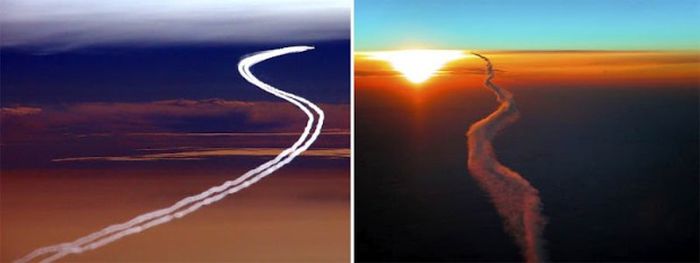|
|
Contrails, Condensation Vapour Trails
|
Contrails, by affecting the Earth's radiation balance, act as a radiative forcing. Studies have found that contrails trap outgoing longwave radiation emitted by the Earth and atmosphere (positive radiative forcing) at a greater rate than they reflect incoming solar radiation (negative radiative forcing). Global radiative forcing has been calculated from the reanalysis data, climatological models and radiative transfer codes. It is estimated to amount to 0.012 W/m2 for 2005, with an uncertainty range of 0.005 to 0.0026 W/m2, and with a low level of scientific understanding. Therefore, the overall net effect of contrails is positive, i.e. a warming effect. However, the effect varies daily and annually, and overall the magnitude of the forcing is not well known: globally (for 1992 air traffic conditions), values range from 3.5 mW/m2 to 17 mW/m2. Other studies have determined that night flights are mostly responsible for the warming effect: while accounting for only 25% of daily air traffic, they contribute 60 to 80% of contrail radiative forcing. Similarly, winter flights account for only 22% of annual air traffic, but contribute half of the annual mean radiative forcing.
• September 11, 2001 climate impact study
The grounding of planes for three days in the United States after September 11, 2001 provided a rare opportunity for scientists to study the effects of contrails on climate forcing. Measurements showed that without contrails, the local diurnal temperature range (difference of day and night temperatures) was about 1 °C (1.8 °F) higher than immediately before; however, it has also been suggested that this was due to unusually clear weather during the period.
Condensation trails have been suspected of causing "regional-scale surface temperature" changes for some time. Researcher David J. Travis, an atmospheric scientist at the University of Wisconsin-Whitewater, has published and spoken on the measurable impacts of contrails on climate change in the science journal Nature and at the American Meteorological Society's 10th Annual conference in Portland, Oregon. The effect of the change in aircraft contrail formation on the three days after the 11th was observed in surface temperature change, measured across over 4,000 reporting stations in the continental United States. Travis' research documented an "anomalous increase in the average diurnal temperature change". The diurnal temperature range (DTR) is the difference in the day's highs and lows at any weather reporting station. Travis observed a 1.8 °C (3.24 °F) departure from the two adjacent three-day periods to the 11th–14th. This increase was the largest recorded in 30 years, more than "2 standard deviations away from the mean DTR".
|
|









